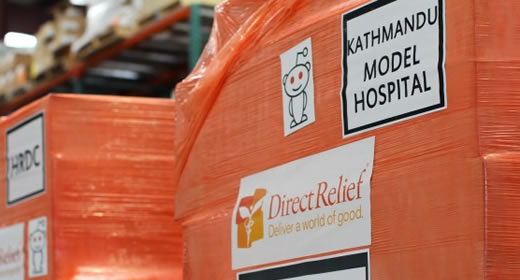
Andrew Schroeder (MPP ’07) knows disaster relief. As director of research and analysis for Direct Relief International, Schroeder has helped shape responses to dozens of calamities. He recites the biggies. Haiti, Sandy, Nargis, Tohoku, Haiyan, and Ebola. Right now, of course, his attention is focused on Nepal.
A benefit of having been through this drill many times, Schroeder seems to see Nepal’s needs unfolding in waves—each with unique challenges, each with life or death consequences.
The first wave? The acutely needed medicine and medical supplies. The 120 pallets of supplies Direct Relief has just shipped—half a cargo plane full—has been divvied into thirds.
Roughly two-thirds have been sent to hospitals that survived the quake, like Nepal Orthopedic Hospital that treats limb trauma in Katmandu, and a number of mobile medical units making their way to rural communities in the mountains high above the city. And one-third has been shipped to Nepal’s Ministry of Health to bolster the public health system and resupply wherever the needs are greatest. Immediate supplies of medical equipment are also in the works. Mobile x-ray units are being brought in to assess trauma in rural areas. Ventilator machines are on their way to improve surgical capacity.
The second wave, bolstering basic clinical needs for recovery of the public health system, is already in process. All the medical procedures that are ordinarily risky in a nation with weak health systems become considerably more dangerous when the health structure has been disrupted. Among the biggest of these risks is childbirth.
Women in developing countries are 23 times more likely to die from maternal-related causes than those in developed countries, according to the World Health Organization. Nepal’s women are even more vulnerable, since the nation is ranked in the lower percentiles for maternal conditions. Add to this the loss of birthing centers from the earthquake, plus the loss of supplies and staff to stemming the tide of quake-related trauma, and the situation is dire. This is why Direct Relief is also sending supplies to teams of midwives—including the international organization Bumi Sehat and One Heart World Wide, which works on this issue across Nepal—to extend services to remote areas.
The third wave, where seismic disruption of the health system meets dynamic circumstances like flooding, hasn’t hit yet. While Schroeder hopes it won’t, he knows that conditions are ripe.
With the loss of housing in Katmandu and surrounding villages, people are crowded together in tents and temporary structures. Moving them out of temporary into rebuilt permanent housing will take time. The city’s sanitation systems weren’t great to begin with, and are considerably worse now. Cholera, endemic to the region, is highly correlated with flooding. And monsoon season begins next month. That’s a recipe for a whole new disaster: infectious disease.
Having participated in an extensive cholera response in Haiti, Schroeder and Direct Relief have well-defined medical supply lists close to hand. “If there’s any indication that that’s going to become an issue in Nepal, it will be relatively straightforward to move the right materials into key locations,” he says.
The fourth wave, rebuilding the health infrastructure, is far less sexy, far more expensive and challenging, but will be vital to long term resilience. Between now and then, the public’s attention will wander away from Nepal, but the fourth wave will last months, maybe years, and Direct Relief will work with local organizations to assist.
Schroeder doesn’t believe in grand Marshall Plan-style responses. Direct Relief’s approach is more nuanced, more iterative, and more sensitive to changing local conditions. It incorporates an interdisciplinary understanding of physical systems like geography, weather, climate, and virology, as well as an understanding of social systems like infrastructure networks, local and regional organizations, demography, behavior, and cultural norms.
“All disasters happen in a specific place, linked with various local, national and international structures that govern how things get done,” he says. “We need to work at the intersection of these systems—hand-in-hand with local actors, national authorities, private markets, and the international humanitarian system—as we map out an effective and resilient response.”
